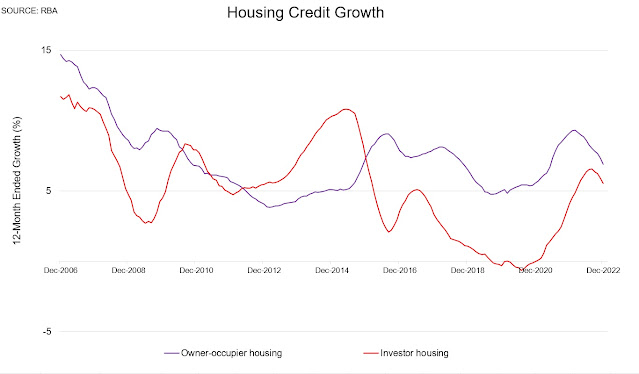Headline inflation peaks at 7.8 per cent
I've previously noted we had one more hyperbolic round of inflation hysteria to go through in Australia, and, yes...today was that lucky day!
Let's take a deep breath and have a good ol' Captain Cook at it all in four short parts...
1 - Headline inflation peaks at 7.8 per cent
Last month the Reserve Bank Governor reported that inflation was expected to peak at around 8 per cent in the fourth quarter of 2022, before declining again in 2023 as global supply issues are now largely being resolved.
As it turned out, inflation rose 1.9 per cent to Q4 to hit 7.8 per cent in for the year, which was a bit below the RBA's expected peak, but rather closer to Treasury's estimate of 73⁄4 per cent.
The quarterly result was nevertheless a little above market and economist expectations, however.
For the next quarter, preliminary estimates for Q1 2023 appear to be looking for quarterly inflation of around 1 per cent, and with a very large 2.1 per cent prior year figure to drop off the annual figure.
Therefore, the headline result will at last begin to fall.
As such, Australia's inflation trajectory continues to track a few months behind other developed countries, such as the US, Canada, UK, Germany, Spain, Portugal, and a slew of other emerging markets countries where the nasty global inflationary spike is already receding (Brazil, Mexico, Chile, Thailand, Poland, etc.).
2 - Underlying inflation also increased
The underlying measures of inflation in Q4 were up by 1.6 per cent (trimmed mean) and 1.7 per cent (weighted median), leading to annual increases of 6.9 per cent and 5.8 per cent respectively.
After six years of undershooting the 2-3 per cent target band, the cost of extended lockdowns and border closures was thus underlying inflation rising to above 6 per cent in 2022.
Annual tradables inflation was flat, while non-tradables inflation increased, largely due to domestic travel costs and electricity prices as rebates were unwound.
3 - The drivers of inflation
One of the critical drivers of inflation in 2022 was housing costs.
Rental price inflation was one small part of it, and this inflation is likely to continue in 2023 as immigration gathers pace.
Moreover, inflation has been rampant across the housing group, with new dwelling purchase by owner-occupiers ballooning nearly 30 per cent higher since June 2020, in part due to the HomeBuilder package and other stimulus programs.
Indeed, the housing group of inflation measures has Federal and State Government fingerprints smeared all over it.
Source: ABS, highlights by @88888s account
Electricity prices were also up by a 'shocking' (sorry) 8.6 per cent, as discounts and concessions ended in some states.
The good news is that new dwelling costs and electricity prices should now ease in 2023, as expertly explained
by James Foster here.
The other key part of the inflation overshoot in the December quarter was a 10.9 per cent increase in holiday, travel, and accommodation costs.
It's normal to see a seasonal increase in recreation, but this year's surge in demand was especially pronounced as the borders reopened and both domestic and international travel was sparked back to life.
Airfares and hotel prices have been very high of late, as anyone who's flown just about anywhere for a holiday will testify!
4 - What next?
This has already been the most dramatic interest rate hiking cycle in living memory, so the question from here is how much further the Reserve Bank looks to hike before taking a breather to assess the impacts of very significant policy tightening to date.
Source: CBA
Before today's inflation figures financial markets were fairly well split on whether there would be a pause in two week's time.
That no longer looks to be on the table, with a 25 basis points rate hike now mostly priced in for February.
OIS pricing by meeting date was nudged modestly higher immediately after today's inflation print, suggesting that the cash rate target by the time of the July and August meetings could be peaking out at 3.60 per cent (i.e. effectively two further interest rate hikes of 25 basis points each).
Source: Martin Whetton, CBA
The wrap
Overall, inflation was a bit higher than markets had expected in Q4, the overshoot being mainly due to travel and holiday accommodation costs, although thankfully the peak for headline inflation appears to have landed just a little lower than where the RBA expected.
The hysteria today was predictable and to be expected, and it often takes a day or so for commentary and markets to calm down and look ahead with a more rational view.
New home sales have already been obliterated, and there's no doubt that price pressures will begin to fall in the construction and housing sector in 2023, as well as other parts of the economy in time.
It's largely question now of how long it takes for the economy to turn sour.
Key releases will be the labour force figures for January and the wage price index for the December quarter, to be released on the 16th and 22nd of February respectively.
---
You can take in an excellent read on price pressures in the services sector, and how housing costs will be a disinflationary force in 2023 from James Foster
here.
---
The Aussie dollar has increased all the way back to where it was in August last year at 71 US cents, which won't hurt from an inflation perspective.























































